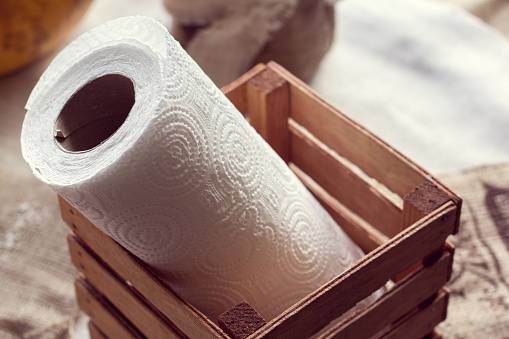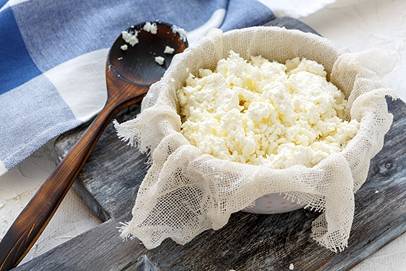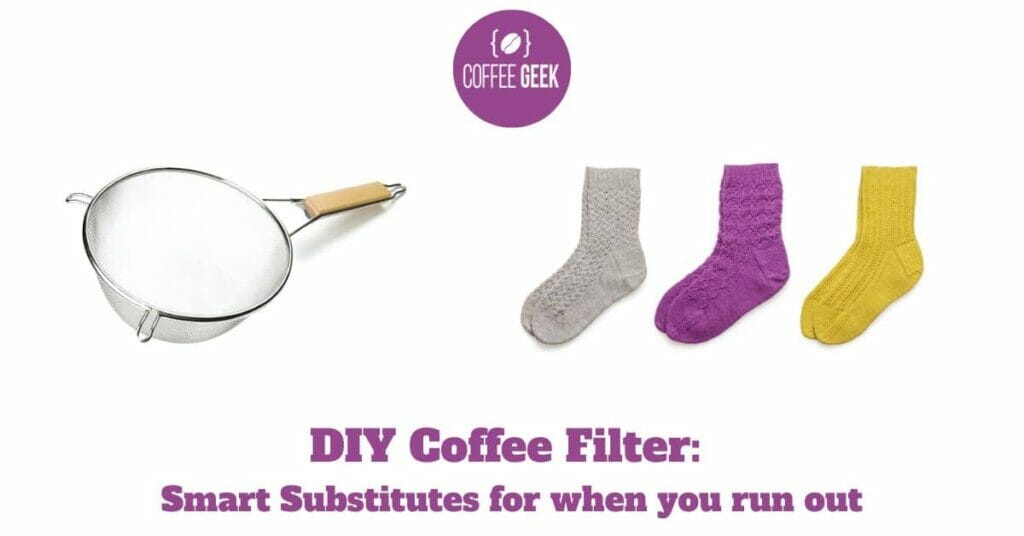Coffee filters are important to ensure no coffee grounds end up in your coffee.
One of the most common uses of coffee filters is for making your favorite pour-over coffee or a cup of French press brew.
However, you can run out of filters to use pretty soon, especially when using them frequently.
And it’s a hassle to go to a store to stock up when you’re about to make coffee, right?

We understand that. The good news is, you can improvise! In this article, we’ll discuss the DIY coffee filters you can use when you run out of them.
So if you want to know what these substitutes are, keep reading!
What is a coffee filter?
A coffee filter is a filter that’s used to filter coffee grounds, making sure that none of it will make its way through your cup of coffee (especially useful if you don’t have a coffee maker).
We don’t like undissolved grounds in our coffee, do we? Coffee filters are made to solve this problem.
They come in different materials: Paper, cloth, and metal.
Paper coffee filter

Paper coffee filters are the most common we know. We usually see it in coffee shops, and maybe we even have it in our homes. This kind of coffee filter is disposable.
This means you typically dispose of it after use, which makes it possible to run out quickly. This also makes it not super environmentally friendly.
Bamboo filters are frequently confused with paper coffee filters. Check out our article on bamboo vs paper coffee filters for a detailed comparison.
Paper coffee filters are commonly used in pour-overs and drip coffee.
What’s good about paper coffee filters is that they’re the most affordable compared to other coffee filters made in different materials.
However, this can easily cost you too much in the long run.
Metal coffee filter

Another common material for coffee filters is metal.
Metal coffee filters are more environmentally friendly since they’re not disposable and can be used for as long as you have them.
However, it’s not as refined as the paper filters. That’s why it can’t catch oils and coffee micro-fines, unlike paper filters.
A metal filter can give you a robust flavor and powerful aroma of coffee. This clearly shows that the filter you use for your coffee can significantly affect the taste of your cup of coffee.
If you want it bolder, then a metal filter is right for you.
Cloth filter

Lastly, the cloth filter. The cloth filter absorbs oil leaving the coffee clear and clean. Like the metal filter, it’s reusable and environmentally friendly but less durable.
Knowing different kinds of coffee filters is important because it will help us find the coffee filter substitutes we can use at home.
So now that we know all about coffee filters let’s now get to the main topic of this article. The coffee filter substitutes.
6 DIY Coffee Filter Substitutes You Have At Home
Here are the coffee filter alternatives you can use:
1. A paper towel

First on the list is a paper towel. It’s one of the most common alternatives to coffee filters. It’s not hard to find, and I’m sure you have it too in your kitchen!
Who would’ve thought that the silent paper towels sitting at the top of your table or countertop were a great alternative when you ran out of coffee filters?
What’s good about paper towels is they can give you the same effect as real coffee filters.
It also does its job of filtering the coffee really well and gives you a brighter, lighter, and grounds-free coffee.
The only cons I see here is the danger of chemicals present in the paper towel. Paper towels undergo a lot of processes to look and work the way they do.
So it’s advisable to be extra careful, especially with the brand or kind of paper towel you use.
To use paper towels as an alternative, you should:
- Place it at the mouth of your mug, securing it with a rubber band, making sure it will not collapse, or else the coffee grinds will also fall into your coffee. If you’re using a brewer, place it on top.
- Add coffee grinds and pour in hot water or let it brew.
- Remove the paper towel, and enjoy your coffee.
2. A clean dish towel or cloth napkin

The second coffee filter substitute we’re going to talk about is the clean dish towel or cloth napkin. We discussed above that a cloth filter is another kind of coffee filter.
This can have the same texture as the original coffee cloth filter, making it one of the best alternatives if you run out of coffee filters.
However, using dish towels or cloth napkins as a coffee filter can result in an unpleasant flavor.
It can also be overly absorbent, absorbing all of the coffee oils and thus removing all of the necessary components.
Nonetheless, it does an excellent job of removing even the smallest grounds. It’s also environmentally friendly, durable, and inexpensive.
To use this as a coffee filter, you need to:
- Choose the perfect and clean dish towel or cloth napkin to use. You have to ensure that what you’re going to use is clean. Also, keep in mind that the cloth may stain, so make sure to use the cloth that you’re ready to sacrifice.
- Place the cloth in the drip basket or pour it over.
- Use a rubber band to secure the towel around the mouth of your mug.
- You can now add coffee grounds on top. Put as much as you want, but make sure it will fit on the towel.
- Pour the hot water over the coffee and set it aside. As you pour it, the water will extract delicious compounds and come out as coffee through the filter, leaving the grounds behind.
- You can now enjoy your freshly brewed coffee without dealing with coffee grounds!
3. Cheesecloth Or Butter Muslins

Another creative way to have a coffee sieve is using cheesecloth or butter muslins. It’s also not common to use this as an alternative since not everyone has it in their homes.
Cheesecloth or butter muslins are initially used for making hard cheese. Same as that, the butter muslins are finer cheesecloth used to drain soft cheeses.
This coffee filter substitute will give you almost the same result as a paper filter.
Although the sizes of the holes are bigger, they can still give you a brighter and fruity flavor of the coffee. It’s a good quality filter that’s also reusable and economically friendly.
However, when it comes to filtering the coffee grounds, some of the smallest grounds can still make their way through. If you don’t mind that, this will suffice.
However, if you want an alternative that filters out even the smallest grounds, other options are available.
To use a cheesecloth or butter muslins as a coffee filter, you have to do the same as the dish towel or cloth napkin:
- If the cloth is too large, cut it and get the size you need. Remember that you need to fold it 2 times to ensure it will filter the grounds well.
- Place it on the mouth of your mug or coffee brewer.
- Add the desired amount of coffee.
- Pour hot water over it, and voila! You can now enjoy your coffee.
4. Cotton socks

Might seem gross to some, but really delivers!
Fourth on the list of our coffee filter substitutes is cotton socks/coffee socks. For some, it’s ridiculous to use socks for filtering coffee.
But you don’t have to use the dirty ones, so what’s ridiculous about it? It will be preferable if you have unused socks you are willing to sacrifice for your morning cup of coffee.
Besides, it works! It’s very good at filtering even the tiniest coffee grinds.
It also won’t give or add any significant taste to your coffee. It’s also reusable, so you can keep it for the next time you run out of filters.
How to use it?
- Place the sock over your mug or pot. Try to stretch it to cover the entire area, but if it’s still unable to do so, you can hold it.
- Put the grounds inside and pour hot water over.
- Another way is to use tea-style brewing. Put the grounds inside and drip them into the hot water.
5. Fine Mesh Sieve

Fine Mesh Sieve. Mesh sieves are generally used to filter unwanted elements.
Mesh sieves have different sizes of holes, so make sure to get the finest one if you’re going to use it as a coffee sieve.
This is a good coffee filter alternative, and it’s very common in many households, so it wouldn’t be hard for you to get one.
However, it doesn’t do the job very well. Even the finest mesh sieve still can’t catch the tiny amount of coffee grains going through your coffee.
But overall, if it’s your only choice, it’s not bad to use it. It’s sturdy, accessible, easy to use, and economically friendly.
To use a Mesh sieve:
- Choose the finest one you have
- Put coffee in it
- Make it sit over your mug or brewer
- Pour water
6. Reusable tea bags

Secondly, the reusable tea bags. We believe that this is the least common alternative to coffee filters.
Reusable tea bags are not hard to find. If you’re also a fan of tea, you might also have it. Otherwise, you can make your own DIY tea bags.
You have to do a little stitching and voila! You have it!
For some, it could be demanding since you have to do a little work, especially when you don’t have reusable tea bags.
However, this method works well! It’s also straightforward when you already have a reusable tea bag.
As it should, it won’t leave any grounds on your coffee.
To use it as an alternative to coffee filters, you should:
- Get the reusable tea bag and put coffee grounds inside.
- Get your coffee cup with hot water in it and place the tea bag inside. Imagine that you’re just making tea, but the outcome is coffee.
- Once you’re satisfied with how long you dip the tea bag into the water, you can remove it and enjoy your cup of coffee!
Conclusion
So there they are! The alternatives for coffee filters. Each has its pros and cons, so be sure to weigh them before choosing what alternatives you will be using.
Nevertheless, all of them work pretty fine; some even work perfectly. You have to be creative and resourceful ‘coz anything around you can be used in this manner.
Thank you so much for reading, and I hope this article was able to help you solve your coffee filter problem!
FAQs
Is baking paper and filter paper the same?
Baking paper and filter paper are entirely different. Baking paper is specifically designed for baking. Therefore, it should be coated with food-grade silicone to prevent food from sticking to it. It’s also resistant to higher baking temperatures.
Do paper coffee filters contain plastic?
Yes, some coffee filters contain small amounts of plastic. Most commonly, polypropylene.
How do you filter coffee without a filter?
If you don’t have a coffee filter, you can use the substitutes discussed above. You can also brew coffee without filters, such as cowboy coffee, or buy instant coffee, which is the simplest option.

